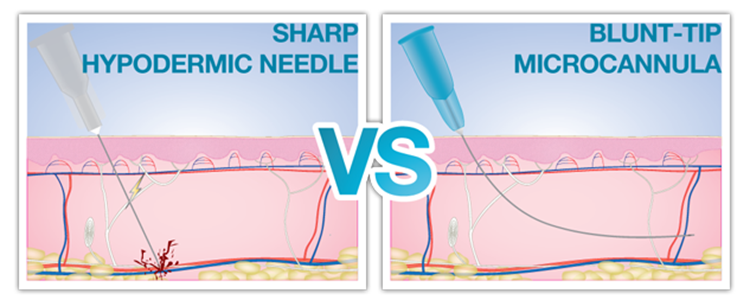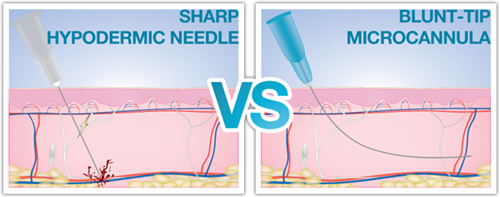
Traditionally, dermal fillers have been administered to the face via a hypodermic needle, however, aesthetic cannulas have become more popular over recent years, particularly for larger areas of the face. Indeed, many dermal filler products are now actually packaged with both a needle and a cannula in order to allow the practitioner more choice when deciding how to inject the product. But as a practitioner, how do we decide between the two methods when treating a patient? In this article, we will explain the main advantages and disadvantages of needles and cannulas and highlight the differences between the two.

Probably the most obvious difference between a needle and a cannula is that the tip of a needle is sharp while a cannula is blunt. One of the main issues when using a needle to administer dermal filler is the likelihood of swelling and bruising post-treatment. Once the needle is inserted, there is a chance that it will pierce the blood vessels underneath the skin, resulting in a bruise. While practitioners can take various measures and use their knowledge of facial anatomy to minimise the risk of bruising, even the most experienced of practitioners can’t guarantee that a patient definitely won’t bruise. In contrast, a cannula does not pose the same risks due to its blunt tip. While a small bore needle is used to make the initial entry point, once the cannula is inserted into the skin, it is far less likely to pierce and pass through the blood vessels. Instead, it simply pushes past the vessels, causing less trauma underneath the skin and therefore, less chance of bruising post treatment.
Another risk relating to the sharp tip of the needle is not just piercing the blood vessel but actually injecting the filler into it, leading to a vascular occlusion which, in turn can result in far more serious complications. Again, there are certain measures that practitioners take to ensure that this doesn’t happen, however, it is something that must be considered when using a needle.
The risk of a vascular occlusion is one of the reasons why many practitioners prefer to use a cannula in “high-risk” areas such as around the eye, as, unlike a needle, a cannula won’t pierce any blood vessels in the area and is therefore less likely to cause any severe complications.
Another major difference between needles and cannulas is that a cannula is generally significantly longer than a needle, and it’s more flexible. Its length and flexibility mean that a cannula allows for smoother, continuous delivery of filler, in areas such as the jawline. It can also be a good solution for patients who are nervous about needles, as far fewer injections are required. A cannula will generally only require a small number of insertion points as it can reach a lot further, which can also mean that the overall treatment is less painful. On the other hand, a needle, being much shorter and rigid, must pierce the skin several times in order for the filler to be delivered across the entire treatment area.
While many practitioners see the flexibility and length of a cannula as one of its major advantages, some also see this as a disadvantage. Indeed, a small needle often allows for more control and accuracy, especially in areas that require a great deal of precision. An example of this is treating the fine “smoker’s lines” around the lips, where a light hand is required to deliver tiny amounts of product quite superficially. In this instance, a cannula simply wouldn’t allow for the same level of control.
Ultimately, there are benefits to both methods, depending on the area being treated, and, in some cases, the patient. It can also come down to personal preference. Some practitioners may feel extremely confident carrying out the majority of their dermal filler procedures using just a needle, or just a cannula, while others may be happy to switch between the two depending on the individual case. Most practitioners will agree that cannula is a useful skill, even if it is not something they use very often. At Facethetics Training, we cover both needle and cannula on all of our filler courses, in order to equip our delegates with the confidence to use either method and the freedom to choose between the two when they treat their own patients.
